Notes: Threlkeld was one of the original stations which opened on 2 January 1865 on the Cockermouth, Keswick & Penrith Railway. It was located about ½-mile south of Threlkeld village close to the farmsteads of Birkett Mire and Setmabanning; a lane which crossed the River Glenderamackin (a tributary of the River Greta) connected the station to the village. The village name, Threlkeld, is of Scandinavian origin, as are many of those in west Cumberland; its meaning is ‘spring of the thralls, or serfs’. The station’s setting is particularly fine, with the huge bulk of the mountain known either as Blencathra or Saddleback (2,847ft) forming the northern horizon.
 The railway through Threlkeld was single track without a crossing loop, the platform being on the north (up) side. Provision of a stationmaster’s house was under way in 1865, located on the north side above the railway cutting; it was designed by John Ross, the CK&P company architect, and constructed by J R Harrison.An early (possibly the first) stationmaster was John Smith, followed by Gresley Walton in September 1866. The original station building was probably of the same design as Troutbeck and several other stations on the line. The railway through Threlkeld was single track without a crossing loop, the platform being on the north (up) side. Provision of a stationmaster’s house was under way in 1865, located on the north side above the railway cutting; it was designed by John Ross, the CK&P company architect, and constructed by J R Harrison.An early (possibly the first) stationmaster was John Smith, followed by Gresley Walton in September 1866. The original station building was probably of the same design as Troutbeck and several other stations on the line.
A semidetached pair of cottages for railwaymen was built after 1887 immediately north of the station house. In 1874 a shed was erected at the station for the benefit of the Saddleback Mining Company which extracted ore on the opposite side of the valley and carted it by road for loading into railway wagons at Threlkeld. As described below, a granite quarry opened a short distance east of the station in the 1870s, and in 1888 a small waiting room was approved for the station for use by the quarrymen. A small village for the quarry workers and their families was built, largely in the 1890s.
Up trains: weekdays
August 1887 |
Destination |
Down trains: weekdays |
Destination |
7.39am |
Penrith |
6.45am ø |
Keswick |
10.04am |
Penrith |
9.04am |
Workington |
12.04pm |
Penrith |
10.31am |
Workington |
4.22pm |
Penrith |
2.26pm |
Workington |
6.49pm |
Penrith |
6.29pm |
Workington |
- |
- |
8.16pm |
Workington |
Up trains: Sunday |
Destination |
Down trains: Sunday |
Destination |
10.19am |
Penrith |
7.36am |
Workington |
6.59pm |
Penrith |
6.36pm |
Workington |
Ø Goods and passenger train; punctuality not guaranteed
 To cope with the increasing traffic on the line it was doubled from Threlkeld eastwards to Troutbeck, which made alterations to Threlkeld station necessary. Whilst Blencow, Penruddock and Troutbeck stations received a second flanking platform when the lines through them were doubled, at Threlkeld an island platform was built. The plan for this reconstruction was drawn up in July 1892 which anticipated the doubling eastwards. The new platform was soon built on the north side of the existing running line and a new line was added to the north of this platform. To cope with the increasing traffic on the line it was doubled from Threlkeld eastwards to Troutbeck, which made alterations to Threlkeld station necessary. Whilst Blencow, Penruddock and Troutbeck stations received a second flanking platform when the lines through them were doubled, at Threlkeld an island platform was built. The plan for this reconstruction was drawn up in July 1892 which anticipated the doubling eastwards. The new platform was soon built on the north side of the existing running line and a new line was added to the north of this platform.
The single-storey building on the new platform was of stone under a pitched slate roof, containing (from east to west) a urinal and gents’ lavatory; a workmen’s waiting room; a gentlemen’s waiting room and lavatory; a ladies’ waiting room and lavatory; the office; and the booking hall/general waiting room. The platform was reached via a subway from the north which emerged in the general waiting room. The entrance to the subway was also stone-built distinguished by a small hipped roof extending to form a canopy. The signal box (opened on 27 September 1893) was an attractive feature of the station abutting the east end of the platform buildings, of stone construction with a hipped roof. On the day that the box opened the crossing of trains at Threlkeld was approved.
Doubling of the line between Threlkeld and Troutbeck began in August 1893 and was completed a year later.

The Railway Clearing House Handbook of 1904 reported that, apart from passengers, Threlkeld station handled general goods, livestock and horse boxes and that a 1ton 10cwt capacity crane was installed. Three short sidings were located directly south of the passenger station, approached from the east, and cattle pens and coal-handling facilities (but without coal cells) were on this site. Two further sidings, one each side of the running lines and approached from the east, were found immediately west of the passenger station, beyond the road underbridge. The sidings serving the Threlkeld Granite Concrete Paving Works were found south-east of the running lines about ¼-mile east of the station; here, the 2ft 4in (approx.) tramway system of the works and quarry reached the standard gauge lines for transfer of materials. In the early 1890s Threlkeld had acted as the railhead for incoming masonry, pipes and valves for the construction of Thirlmere Reservoir, several miles south of the station.
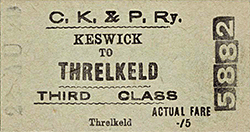 A prominent feature on the mountain slope to the north of Threlkeld was Blencathra Sanatorium, opened in 1904 (and active today as a Field Studies Council study residential study centre). Visitors to the sanatorium accounted for some of the users of Threlkeld station, as were quarry workers, travelling from and to Keswick by a special morning and evening train: by 1906 on weekdays a workmen’s train bound for Threlkeld left Keswick at 6.55am and a homebound train left Threlkeld at 5.35pm (12.55pm on Saturday). These timings changed during the years, and the service operated until at least 1929, and probably into the 1930s. The trains usually consisted of one or two coaches. A prominent feature on the mountain slope to the north of Threlkeld was Blencathra Sanatorium, opened in 1904 (and active today as a Field Studies Council study residential study centre). Visitors to the sanatorium accounted for some of the users of Threlkeld station, as were quarry workers, travelling from and to Keswick by a special morning and evening train: by 1906 on weekdays a workmen’s train bound for Threlkeld left Keswick at 6.55am and a homebound train left Threlkeld at 5.35pm (12.55pm on Saturday). These timings changed during the years, and the service operated until at least 1929, and probably into the 1930s. The trains usually consisted of one or two coaches.
Unusually, the minor stations between Cockermouth and Penrith were lit by gas for much of their lives. At first, oil lighting was used but at Threlkeld, from April 1902, an acetylene gas plant provided lighting for the station; the plant was large enough to provide power for fifty lamps (although its replacement in 1916 could light only forty lamps).
In 1918 a rather unsightly lean-to structure was added at the west end of the signal box serving as a coalhouse and lamp room.
Up trains: weekdays
June 1920 |
Destination |
Down trains: weekdays |
Destination |
7.48am |
Penrith |
8.04am |
Workington |
9.35am |
Penrith |
10.29am |
Workington |
12.03pm |
Penrith |
1.47pm |
Workington |
3.14pm |
Penrith |
3.31pm |
Workington |
6.39pm |
Penrith |
6.49pm |
Workington |
7.53pm |
Penrith |
8.54pm |
Workington |
No Sunday service
In January 1923 the station became part of the new London, Midland & Scottish Railway (LMS). Little changed at Threlkeld station under this administration but activity at the nearby granite works and quarry declined. In 1932 Threlkeld’s stationmaster’s responsibilities were extended to supervising Troutbeck, the next station eastward.
Up trains: weekdays
6 May to 6 Oct 1946 |
Destination |
Down trains: weekdays |
Destination |
8.03am |
Penrith |
8.05am |
Workington |
9.15am SX ¶ |
Penrith |
10.46am † |
Workington |
11.17am SO § |
Liverpool Exchange |
11.47am ‖ |
Workington |
12.22pm ‡ |
Penrith |
1.58pm # |
Workington |
1.11pm |
Penrith |
2.53pm |
Keswick |
3.32pm SX |
Penrith |
3.23pm SO ++ |
Cockermouth |
3.54pm SO |
Penrith |
5.28pm SX |
Workington |
5.04pm ø |
Penrith |
5.55pm MFSO |
Workington |
6.41pm |
Penrith |
6.56pm |
Keswick ~ |
7.49pm |
Penrith |
8.43pm |
Workington |
No Sunday service
SX Saturday excepted SO Saturday only MFSO Monday, Friday and Saturday only
‡ 6 minutes later on Monday, Friday and Saturday Ø 9 minutes later on Monday
† 8 minutes later on Monday, Friday and Saturday
‖ 7 minutes later on Tuesday, Wednesday and Thursday
~ Continues to Workington on Saturday
¶ From 8 June # 18 May to 28 September ++ 15 June to 21 September
§ 22 June to 14 September
 In January 1948 at nationalisation Threlkeld became part of the new British Railways (BR) London Midland Region (LM). The former CK&P saw the introduction of diesel multiple units in January 1955 which gradually replaced steam-hauled passenger trains. In the summer 1956 timetable (below) Sunday trains commenced on the line; they did not serve all intermediate stations but did call at Threlkeld. In January 1948 at nationalisation Threlkeld became part of the new British Railways (BR) London Midland Region (LM). The former CK&P saw the introduction of diesel multiple units in January 1955 which gradually replaced steam-hauled passenger trains. In the summer 1956 timetable (below) Sunday trains commenced on the line; they did not serve all intermediate stations but did call at Threlkeld.
Up trains: weekdays
11 Jun – 16 Sep 1956 |
Destination |
Down trains: weekdays |
Destination |
8.03am |
Carlisle |
7.41am |
Workington |
10.43am |
Carlisle ‡ |
10.45am |
Workington |
12.27pm |
Penrith |
12.08pm |
Workington |
1.16pm |
Carlisle |
1.57pm |
Workington |
2.18pm |
Penrith |
2.22pm SO § |
Workington |
3.57pm |
Penrith |
3.40pm SX |
Workington |
6.22pm |
Carlisle |
4.05pm SO |
Workington |
7.34pm |
Penrith- |
5.35pm |
Workington |
- |
= |
6.48pm |
Workington † |
- |
- |
7.09pm # |
Workington |
- |
= |
8.43pm~ |
Workington |
Up trains: Sunday |
Destination |
Down trains: Sunday |
Destination |
9.50am |
Carlisle |
9.57am |
Workington |
12.05pm |
Carlisle |
11.47am |
Whitehaven |
4.22pm |
Carlisle |
1.01pm |
Keswick |
Sunday services operate until 2 September 1956
SX Saturday excepted SO Saturday only § 22 June to 1 September
# 9 July to 7 Sep SX; until 8 September SO ‡ Terminates at Penrith SO
† Continues to Whitehaven SO ~ 2 minutes later on Saturday
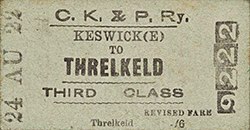 The station, along with most of the others on the Workington – Penrith line, was fitted with BR(LM) maroon vitreous enamel nameboards and totem lamp tablets, probably in the late 1950s. Although the station had been gas-lit the lanterns in use by the late 1950s/early 1960s held oil lamps as the gas equipment had worn out. As part of a BR policy to close minor stations’ goods facilities, all goods yards were closed on the former CK&P on 1 June 1964. Mineral traffic from the nearby quarry had dwindled and ceased to be handled by rail in 1964; the quarry itself closed in 1982. The station, along with most of the others on the Workington – Penrith line, was fitted with BR(LM) maroon vitreous enamel nameboards and totem lamp tablets, probably in the late 1950s. Although the station had been gas-lit the lanterns in use by the late 1950s/early 1960s held oil lamps as the gas equipment had worn out. As part of a BR policy to close minor stations’ goods facilities, all goods yards were closed on the former CK&P on 1 June 1964. Mineral traffic from the nearby quarry had dwindled and ceased to be handled by rail in 1964; the quarry itself closed in 1982.
Up trains: weekdays
14 June 1965 to 17 April 1966 |
Destination |
Down trains: weekdays |
Destination |
07.56 |
Carlisle |
07.42 |
Workington |
10.14 |
Carlisle |
09.59 |
Workington |
12.46 |
Penrith |
12.03 |
Keswick |
13.16 |
Carlisle |
14.01 |
Workington |
16.13 |
Carlisle ¶ |
17.28 |
Workington |
19.02 |
Penrith |
18.36 |
Workington |
20.04 ɫ |
Carlisle |
20.10 ɫ |
Woerkington |
No Sunday service
¶ Terminates at Penrith Friday and Saturday 18 June to 4 September
ɫ Calls to set down passengers
 Whilst the Keswick - Workington section of the former CK&P closed to all traffic in April 1966 the Penrith-Keswick service continued for several years, but economies were made in operating the remaining branch. The station’s signal box closed on 4 December 1967; this was the day on which the operation of the branch went over to ‘one engine in steam’ – effectively one long siding. The down track through the station was removed. Along with the other branch stations, Threlkeld was unstaffed from 1 July 1968. In the mid 1960s electric lighting was installed, replacing oil lanterns. Whilst the Keswick - Workington section of the former CK&P closed to all traffic in April 1966 the Penrith-Keswick service continued for several years, but economies were made in operating the remaining branch. The station’s signal box closed on 4 December 1967; this was the day on which the operation of the branch went over to ‘one engine in steam’ – effectively one long siding. The down track through the station was removed. Along with the other branch stations, Threlkeld was unstaffed from 1 July 1968. In the mid 1960s electric lighting was installed, replacing oil lanterns.

The timetable below would prove to be the last for Threlkeld as the Penrith-Keswick branch closed on 6 March 1972.
Up trains: weekdays
3 May 1971 |
Destination |
Down trains: weekdays |
Destination |
07.47 |
Carlisle |
07.17 |
Keswick |
11.12 |
Penrith |
10.23 |
Keswick |
13.22 |
Penrith |
12.37 |
Keswick |
15.37 |
Penrith |
14.42 |
Keswick |
17.12 |
Penrith |
16.52 |
Keswick |
19.12 |
Carlisle |
18.52 |
Keswick |
No Sunday service
 The platform and buildings remained in place after the rails were removed, but the lever frame was taken out of the signal box. However demolition of the buildings, including the ‘gas house’ was carried out during 1985-86. The island platform was in place but invaded by trees when visited in January 2010 and photographic evidence from February 2013 shows that the platform was still extant. However, by May 2015 the platform had been covered with spoil and the adjacent goods yard site to the south was a council depot. In 2018 the station house and the staff cottages remained in use. In 2019, the west end of the platforms south face survives within the council depot as does part of the cattle dock opposite. A footpath runs along the north side of the platform outside the council depot, although the track bed has been filled up to platform level some platform edge stones survive. The platform and buildings remained in place after the rails were removed, but the lever frame was taken out of the signal box. However demolition of the buildings, including the ‘gas house’ was carried out during 1985-86. The island platform was in place but invaded by trees when visited in January 2010 and photographic evidence from February 2013 shows that the platform was still extant. However, by May 2015 the platform had been covered with spoil and the adjacent goods yard site to the south was a council depot. In 2018 the station house and the staff cottages remained in use. In 2019, the west end of the platforms south face survives within the council depot as does part of the cattle dock opposite. A footpath runs along the north side of the platform outside the council depot, although the track bed has been filled up to platform level some platform edge stones survive.
Route map drawn by Alan Young. Tickets from Michael Stewart.. Totem Richard Furness
To see the other
stations on the Cockermouth - Penrith line click on the station name: Cockermouth 1st, Cockermouth 2nd, Embleton, Bassenthwaite Lake, Braithwaite, Keswick, Briery Siding Halt, Highgate Platform, Troutbeck, Penruddock & Blencow
Click here for a brief history of the Cockermouth, Keswick and Penrith Railway |

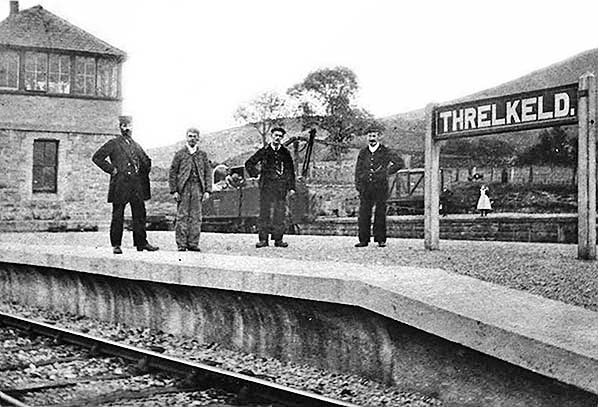





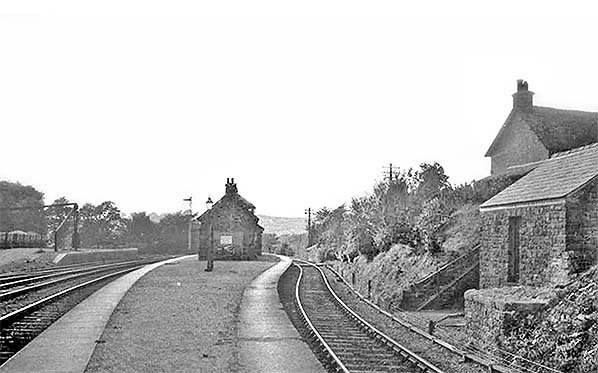 Looking west from the east end of Threlkeld station c1950. The stationmaster's house is seen on the right with steps down from the house to the track alongside the platelayers' hut. The rake of waggons seen far left is from the Granite quarry, and the siding on which they stand was removed in the late 1940s or early 1950s. The pipe-like structure close to the waggons was a support for a jib crane which had possibly been installed when the yard was used in the 1890s to receive construction materials for the Thirlmere Dam project. Thanks to Keith Wren for contributing content for this caption.
Looking west from the east end of Threlkeld station c1950. The stationmaster's house is seen on the right with steps down from the house to the track alongside the platelayers' hut. The rake of waggons seen far left is from the Granite quarry, and the siding on which they stand was removed in the late 1940s or early 1950s. The pipe-like structure close to the waggons was a support for a jib crane which had possibly been installed when the yard was used in the 1890s to receive construction materials for the Thirlmere Dam project. Thanks to Keith Wren for contributing content for this caption.

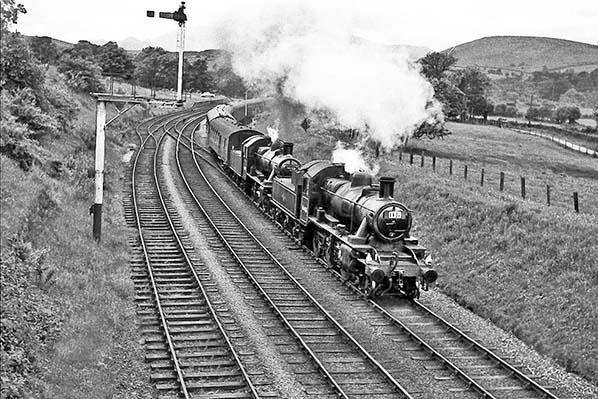 The R.C.T.S. (West Riding Branch) 'The Solway Ranger' has just passed through Threlkeld station on 13 June 1964. The tour started and ended at Leeds City with multiple steam and diesel traction. The leg from Penrith to Workington Main, seen here, was hauled by two Ivatt 2-6-0's 46426 and 46458. After the Ivatts reached Workington the majority of the passengers transferred to a DMU whilst the stock and the two locos set off for Carlisle via Penrith. A tour ticket letter carried a hand-written note, 'to return by steam from Workington to Carlisle. Not available on DMU’, suggesting that the stock carried some tour passengers. Threlkeld cattle dock is seen in the left distance with one siding running behind the dock.
The R.C.T.S. (West Riding Branch) 'The Solway Ranger' has just passed through Threlkeld station on 13 June 1964. The tour started and ended at Leeds City with multiple steam and diesel traction. The leg from Penrith to Workington Main, seen here, was hauled by two Ivatt 2-6-0's 46426 and 46458. After the Ivatts reached Workington the majority of the passengers transferred to a DMU whilst the stock and the two locos set off for Carlisle via Penrith. A tour ticket letter carried a hand-written note, 'to return by steam from Workington to Carlisle. Not available on DMU’, suggesting that the stock carried some tour passengers. Threlkeld cattle dock is seen in the left distance with one siding running behind the dock. Ivatt 2MT 2-6-0 No.46432 is again seen at Threlkeld, this time with ex-LMS carriages circa mid 1960s. The lamp room added to the west end of the signal box in 1918 is clearly visible. The cattle dock is to the right with a clearer view of the yard crane and the metal pipes that run across the adjacent siding from the dock,
Ivatt 2MT 2-6-0 No.46432 is again seen at Threlkeld, this time with ex-LMS carriages circa mid 1960s. The lamp room added to the west end of the signal box in 1918 is clearly visible. The cattle dock is to the right with a clearer view of the yard crane and the metal pipes that run across the adjacent siding from the dock,
 The railway through Threlkeld was single track without a crossing loop, the platform being on the north (up) side. Provision of a stationmaster’s house was under way in 1865, located on the north side above the railway cutting; it was designed by John Ross, the CK&P company architect, and constructed by J R Harrison.An early (possibly the first) stationmaster was John Smith, followed by Gresley Walton in September 1866. The original station building was probably of the same design as Troutbeck and several other stations on the line.
The railway through Threlkeld was single track without a crossing loop, the platform being on the north (up) side. Provision of a stationmaster’s house was under way in 1865, located on the north side above the railway cutting; it was designed by John Ross, the CK&P company architect, and constructed by J R Harrison.An early (possibly the first) stationmaster was John Smith, followed by Gresley Walton in September 1866. The original station building was probably of the same design as Troutbeck and several other stations on the line. To cope with the increasing traffic on the line it was doubled from Threlkeld eastwards to Troutbeck, which made alterations to Threlkeld station necessary. Whilst Blencow, Penruddock and Troutbeck stations received a second flanking platform when the lines through them were doubled, at Threlkeld an island platform was built. The plan for this reconstruction was drawn up in July 1892 which anticipated the doubling eastwards. The new platform was soon built on the north side of the existing running line and a new line was added to the north of this platform.
To cope with the increasing traffic on the line it was doubled from Threlkeld eastwards to Troutbeck, which made alterations to Threlkeld station necessary. Whilst Blencow, Penruddock and Troutbeck stations received a second flanking platform when the lines through them were doubled, at Threlkeld an island platform was built. The plan for this reconstruction was drawn up in July 1892 which anticipated the doubling eastwards. The new platform was soon built on the north side of the existing running line and a new line was added to the north of this platform. 
 A prominent feature on the mountain slope to the north of Threlkeld was Blencathra Sanatorium, opened in 1904 (and active today as a Field Studies Council study residential study centre). Visitors to the sanatorium accounted for some of the users of Threlkeld station, as were quarry workers, travelling from and to Keswick by a special morning and evening train: by 1906 on weekdays a workmen’s train bound for Threlkeld left Keswick at 6.55am and a homebound train left Threlkeld at 5.35pm (12.55pm on Saturday). These timings changed during the years, and the service operated until at least 1929, and probably into the 1930s. The trains usually consisted of one or two coaches.
A prominent feature on the mountain slope to the north of Threlkeld was Blencathra Sanatorium, opened in 1904 (and active today as a Field Studies Council study residential study centre). Visitors to the sanatorium accounted for some of the users of Threlkeld station, as were quarry workers, travelling from and to Keswick by a special morning and evening train: by 1906 on weekdays a workmen’s train bound for Threlkeld left Keswick at 6.55am and a homebound train left Threlkeld at 5.35pm (12.55pm on Saturday). These timings changed during the years, and the service operated until at least 1929, and probably into the 1930s. The trains usually consisted of one or two coaches. In January 1948 at nationalisation Threlkeld became part of the new British Railways (BR) London Midland Region (LM). The former CK&P saw the introduction of diesel multiple units in January 1955 which gradually replaced steam-hauled passenger trains. In the summer 1956 timetable (below) Sunday trains commenced on the line; they did not serve all intermediate stations but did call at Threlkeld.
In January 1948 at nationalisation Threlkeld became part of the new British Railways (BR) London Midland Region (LM). The former CK&P saw the introduction of diesel multiple units in January 1955 which gradually replaced steam-hauled passenger trains. In the summer 1956 timetable (below) Sunday trains commenced on the line; they did not serve all intermediate stations but did call at Threlkeld. The station, along with most of the others on the Workington – Penrith line, was fitted with BR(LM) maroon vitreous enamel nameboards and totem lamp tablets, probably in the late 1950s. Although the station had been gas-lit the lanterns in use by the late 1950s/early 1960s held oil lamps as the gas equipment had worn out. As part of a BR policy to close minor stations’ goods facilities, all goods yards were closed on the former CK&P on 1 June 1964. Mineral traffic from the nearby quarry had dwindled and ceased to be handled by rail in 1964; the quarry itself closed in 1982.
The station, along with most of the others on the Workington – Penrith line, was fitted with BR(LM) maroon vitreous enamel nameboards and totem lamp tablets, probably in the late 1950s. Although the station had been gas-lit the lanterns in use by the late 1950s/early 1960s held oil lamps as the gas equipment had worn out. As part of a BR policy to close minor stations’ goods facilities, all goods yards were closed on the former CK&P on 1 June 1964. Mineral traffic from the nearby quarry had dwindled and ceased to be handled by rail in 1964; the quarry itself closed in 1982. Whilst the Keswick - Workington section of the former CK&P closed to all traffic in April 1966 the Penrith-Keswick service continued for several years, but economies were made in operating the remaining branch. The station’s signal box closed on 4 December 1967; this was the day on which the operation of the branch went over to ‘one engine in steam’ – effectively one long siding. The down track through the station was removed. Along with the other branch stations, Threlkeld was unstaffed from 1 July 1968. In the mid 1960s electric lighting was installed, replacing oil lanterns.
Whilst the Keswick - Workington section of the former CK&P closed to all traffic in April 1966 the Penrith-Keswick service continued for several years, but economies were made in operating the remaining branch. The station’s signal box closed on 4 December 1967; this was the day on which the operation of the branch went over to ‘one engine in steam’ – effectively one long siding. The down track through the station was removed. Along with the other branch stations, Threlkeld was unstaffed from 1 July 1968. In the mid 1960s electric lighting was installed, replacing oil lanterns.
 The platform and buildings remained in place after the rails were removed, but the lever frame was taken out of the signal box. However demolition of the buildings, including the ‘gas house’ was carried out during 1985-86. The island platform was in place but invaded by trees when visited in January 2010 and photographic evidence from February 2013 shows that the platform was still extant. However, by May 2015 the platform had been covered with spoil and the adjacent goods yard site to the south was a council depot. In 2018 the station house and the staff cottages remained in use. In 2019, the west end of the platforms south face survives within the council depot as does part of the cattle dock opposite. A footpath runs along the north side of the platform outside the council depot, although the track bed has been filled up to platform level some platform edge stones survive.
The platform and buildings remained in place after the rails were removed, but the lever frame was taken out of the signal box. However demolition of the buildings, including the ‘gas house’ was carried out during 1985-86. The island platform was in place but invaded by trees when visited in January 2010 and photographic evidence from February 2013 shows that the platform was still extant. However, by May 2015 the platform had been covered with spoil and the adjacent goods yard site to the south was a council depot. In 2018 the station house and the staff cottages remained in use. In 2019, the west end of the platforms south face survives within the council depot as does part of the cattle dock opposite. A footpath runs along the north side of the platform outside the council depot, although the track bed has been filled up to platform level some platform edge stones survive.
 Home Page
Home Page